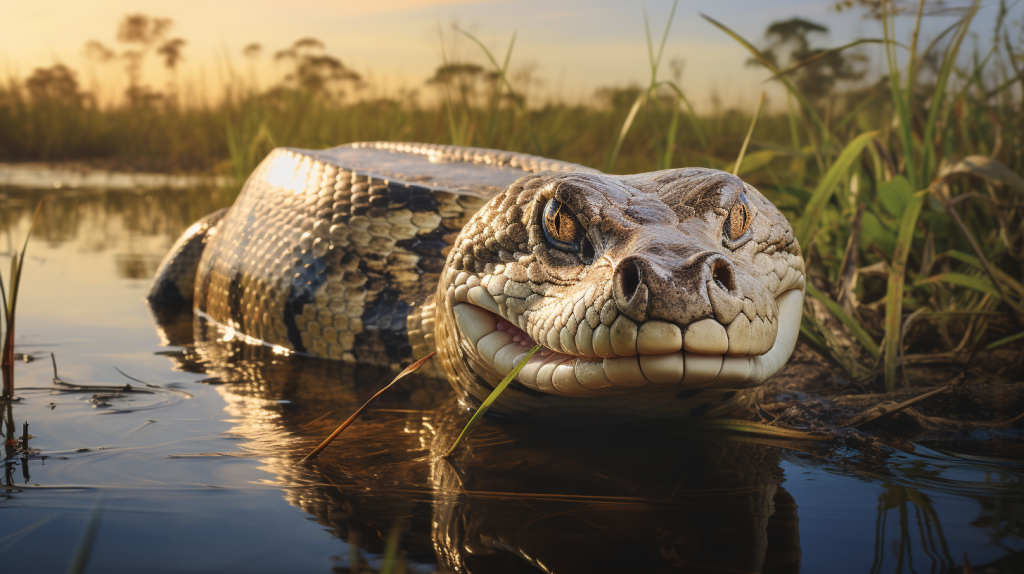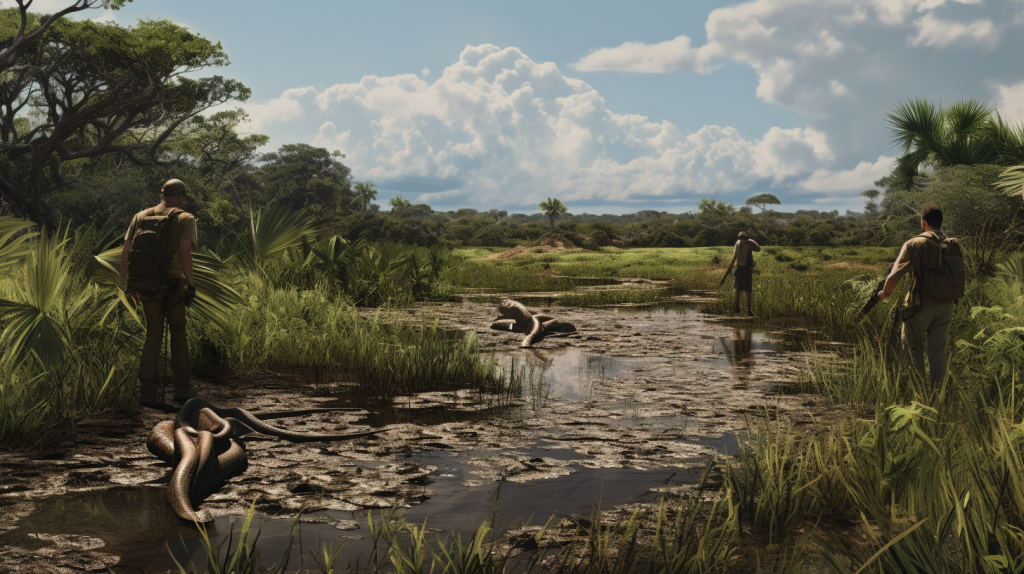Worried about Florida pythons moving north? If someone told you a decade ago that Florida pythons might become a concern for states north of the Sunshine State, would you have believed them? Well, pinch yourself because it’s happening! The expanse of these invasive reptiles isn’t just a late-night Sci-Fi movie plot—it’s a real-life ecological thriller that’s unfolding right now.
1. The Start of The Slithering Saga
Decades ago, Florida’s sprawling wetlands and tropical ambiance became an unintended home for a foreign invader. The Burmese python, originally native to the dense forests of Southeast Asia, began its dominance in the Florida Everglades due to the booming exotic pet trade.
As the demand for unique and thrilling pets grew in the latter half of the 20th century, many Floridians sought these enormous reptiles, drawn by their alluring patterns and the status of owning such a creature. But as these pythons grew, their requirements became overwhelming for many households, leading to their subsequent release into the wild.
2. An Unexpected Invasion
While Florida boasts a plethora of exotic wildlife, the introduction of the Burmese python was unprecedented. Their exponential population growth, combined with a lack of natural predators, provided them with unparalleled dominance in their new environment. Add to this mix their remarkable adaptability, and Florida’s native species soon found themselves competing with an unexpected and formidable rival.
3. Why Are They Moving North?
Global climate change is reshaping the habitats of countless species, including the Burmese python. As temperatures rise, areas once too cold for these cold-blooded creatures have become accessible. The warmer winters and milder climates of the states north of Florida now provide potential new homes for these reptiles, allowing their range to expand beyond what was previously imaginable.
4. What Does This Mean for Local Ecosystems?
The presence of an apex predator like the Burmese python has profound implications for local ecosystems. Their diverse diet, which includes animals from small rodents to larger mammals like deer, disrupts the food chain. With pythons consuming a broad range of species, native populations are threatened, which can cascade down the ecological ladder and affect everything from plant life to water quality.
5. The Economic Impact
Beyond ecological concerns, the python invasion has economic repercussions. Florida’s diverse ecosystems support lucrative industries, including tourism, fishing, and hunting. As pythons decimate native populations, these industries could face declining revenues. Moreover, managing and controlling the python population requires significant financial investments from state and local governments.
6. A Wake-Up Call for Conservationists
The python’s dominance in Florida highlights the need for proactive conservation strategies. It’s an urgent call for innovative solutions, whether in the form of advanced tracking technologies, community-based initiatives, or enhanced legislative measures. The scenario underscores the broader challenges conservationists face in a rapidly changing world.
7. Potential Benefits?
While the negative impacts of the python invasion are evident, there’s potential for a silver lining. These reptiles, due to their voracious appetite, could aid in controlling some pest populations. This unexpected benefit, however, must be weighed against the broader ecological disturbances they cause, making it a complex issue to navigate.
8. Community Response
Community awareness and involvement are crucial in addressing the python problem. Educating locals about safe practices, what to do when encountering a python, and how to prevent further spread are of utmost importance. Furthermore, fostering a sense of collective responsibility can mobilize communities to actively participate in mitigation efforts.
9. Looking Into The Future
Predicting the exact trajectory of the python’s northern migration is challenging. However, what’s clear is that as they continue to move, they’ll reshape the landscapes they traverse. The python’s journey serves as a poignant reminder of the unforeseen challenges ecosystems might face in the future, emphasizing the need for continuous monitoring and adaptability.
10. Adapting To Our Changing World
The Burmese python saga in Florida isn’t just about one species—it’s a snapshot of the broader environmental changes we’re witnessing. As these reptiles adapt to a changing world, it’s a clarion call for humanity to do the same. Their expansion teaches us about resilience, adaptability, and the intricate, often unexpected ways in which all life on Earth is interconnected.
Should The States North Of Florida Be Worried?
When considering the ongoing narrative of the Burmese python’s northward migration from Florida, a crucial question emerges for neighboring states: is there genuine cause for concern? The answer, unfortunately, is multifaceted and hinges upon various ecological, economic, and social considerations.
1. Ecological Impact:
The most immediate concern is the potential ecological disruption these apex predators can cause. The Burmese python’s expansive diet includes birds, mammals, and even other reptiles. In Florida, their voracious appetite has already been linked to significant declines in certain mammal populations. If these pythons establish themselves in new territories, they could threaten local biodiversity, upsetting established food chains and ecological balance.
2. Economic Repercussions:
Florida has already witnessed the economic strains posed by the python invasion. If pythons continue their migration, other states might face similar challenges. Industries that rely on native species, such as hunting and fishing, could see dwindling returns. Additionally, the costs associated with python management and control – from public awareness campaigns to removal programs – can strain local budgets.
3. Safety Concerns:
While Burmese pythons are generally not a direct threat to humans, their mere presence can raise safety concerns. These pythons can pose a danger to pets and small livestock. Additionally, human-python encounters can cause panic or lead to accidents, especially if individuals try to handle or remove the snakes without proper training.
4. Opportunities for Invasive Species:
The success of the Burmese python in Florida showcases the adaptability of invasive species. If pythons find suitable habitats in states north of Florida, it could signal that these regions are vulnerable to other invasive species as well, potentially leading to a series of ecological challenges.
5. Climate Change Implications:
The python’s migration serves as a tangible indicator of broader environmental changes, primarily driven by climate change. If pythons, sensitive to colder temperatures, are now venturing north, what other species might be expanding their range due to shifting climates? It’s a stark reminder of the unpredictable and far-reaching impacts of global climate change.
Final Thoughts On Florida Pythons Moving North
The northward migration of Florida pythons is not just an isolated issue but a reflection of the broader ecological changes we’re facing. As we grapple with this reality, one can’t help but wonder—what else does the future have in store?
FAQs:
- How did the Burmese python first arrive in Florida?
- They were primarily introduced via the exotic pet trade and eventually found their way into the wild.
- Are there any predators for the Burmese python in Florida?
- In Florida, pythons have few natural predators, which is one of the reasons for their rapid population growth.
- How can communities safeguard against the python invasion?
- Education and community engagement are critical. People should be made aware of the risks and informed about prevention methods.
- What are the potential economic repercussions of the python migration?
- As native species decline due to predation by pythons, industries like fishing and hunting may face challenges.
- Can we expect pythons to move beyond the northern states of the USA?
- It largely depends on environmental factors and how well they adapt. But as climate change progresses, it’s a possibility that they could find new territories to inhabit.





